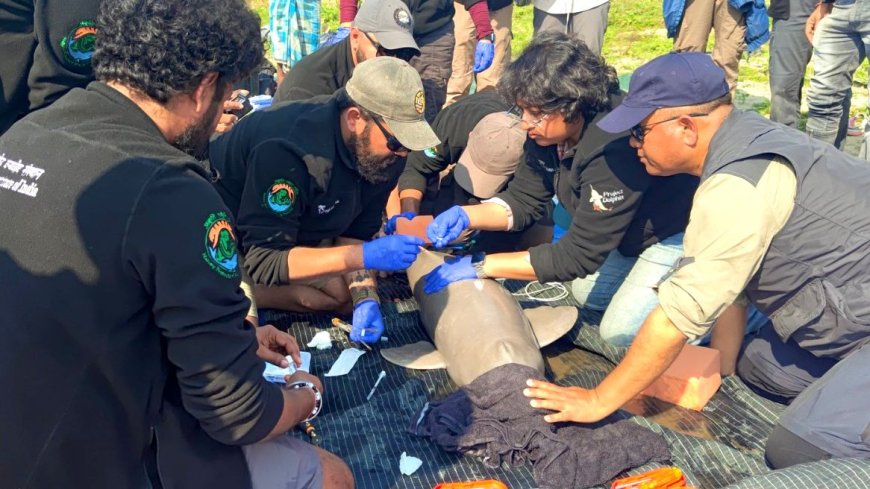Historic Milestone for Conservation: India Conducts First-Ever Ganges River Dolphin Tagging in Assam
In a groundbreaking achievement for wildlife conservation, the first-ever tagging of a Ganges River Dolphin (Platanista gangetica) was done in Assam. The post Historic Milestone for Conservation: India Conducts First-Ever Ganges River Dolphin Tagging in Assam appeared first on Hub News.

Guwahati, Dec 18: In a groundbreaking achievement for wildlife conservation, the first-ever tagging of a Ganges River Dolphin (Platanista gangetica) was done in Assam.
This historic initiative, led by the Ministry of Environment, Forest and Climate Change (MoEFCC), was implemented by the Wildlife Institute of India (WII) in collaboration with the Assam Forest Department and Aaranyak, with financial backing from the National CAMPA Authority. This achievement is a pivotal step for Project Dolphin, launched under the visionary leadership of Prime Minister Narendra Modi, marking the first time this endangered species has been tagged not only in India but globally.
The Ganges River Dolphin, recognized as India’s National Aquatic Animal, holds a unique place in the country’s ecological tapestry. Nearly blind, these dolphins rely on echolocation for navigation, feeding, and social interactions. Approximately 90% of the global population of Ganges River Dolphins resides in India, historically inhabiting the Ganga-Brahmaputra-Meghna and Karnaphuli river systems. However, their range has significantly contracted over the past century due to habitat loss, pollution, and human disturbances.
Despite being a keystone species that indicates the health of the river ecosystem, major knowledge gaps persist regarding its habitat needs, movement patterns, and population dynamics, as the species surfaces for only 5 to 30 seconds at a time, making observation and data collection challenging.
Recognizing these challenges, Project Dolphin aims to bridge knowledge gaps and develop evidence-based conservation strategies. Under the umbrella of this initiative, the MoEFCC has tasked the Wildlife Institute of India with conducting range-wide research to inform a long-term conservation action plan. The project’s goal is to ensure the sustainability of the river ecosystem, as the well-being of apex predators like the Ganges River Dolphin is directly linked to the health of the aquatic environment and the livelihoods of thousands who depend on it.
The decision to conduct satellite tagging of dolphins is a vital step in achieving these goals. The first tagging operation took place in Assam, where a healthy male river dolphin was fitted with a lightweight satellite tag and released back into the river under strict veterinary supervision. The tagging is designed to have minimal impact on the animal’s natural behaviour, and the Argos satellite-compatible tags will transmit crucial data on the dolphin’s movements, habitat usage, and seasonal migration patterns. This information will be invaluable for developing targeted conservation actions, particularly in fragmented or disturbed river systems.
Minister of Environment, Forest, and Climate Change, Shri Bhupender Yadav, hailed the achievement, stating, “I am happy to share the news of the first-ever tagging of a Ganges River Dolphin in Assam—a historic milestone for the species and for India! This MoEFCC and National CAMPA-funded project, led by the Wildlife Institute of India, in collaboration with the Assam Forest Department and Aaranyak, will deepen our understanding of conserving our National Aquatic Animal.”
Director of the Wildlife Institute of India, Virendra R. Tiwari, echoed this sentiment, stating, “Tagging river dolphins will contribute to evidence-based conservation strategies that are urgently needed for this species. I am delighted that this historic step has been undertaken.”
Project investigatorDr. Vishnupriya Kolipakam highlighted the broader impact of the initiative, saying, “This is a significant advancement in understanding the ecological needs of river dolphins, which will help conserve critical habitats within these vast river ecosystems. This is vital not only for aquatic biodiversity but also for sustaining thousands of people who depend on these resources.”
Assam Chief Minister Himanta Biswa Sarma said on X- https://x.com/himantabiswa/status/1869369310126473570
Historic Initiative to protect 






































